Video Deck Frequency Response
5 MHz Sweep on Waveform Monitor
This is a comparison of several different video recorders based on
frequency response of the recorded and played-back test signal. All of this
data is courtesy of Brent who
emailed it to me. I'm not an expert in interpreting these images, but the
key item is the amplitude of the signal as you move to the right (increase
in frequency from 0 to 5 MHz). By this measure it looks like MiniDV is
mostly worse than Betacam SP, which I can believe, and maybe even SVHS,
which I don't believe (picture quality from my TRV900 MiniDV definitely
falls off when recorded on my AG-1980 SVHS deck).
Of possible significance also is the "cleanliness" of the edges of the
signal, if they're fuzzy it may indicate the presence of video noise. (?
Can any experts to correct me on this?) For instance if you had a small but
perfectly clean signal, you could use a "processing amp" to increase the
higher frequency levels, but any real signal has some noise; amplifying it
makes the noise more visible.
It is worth pointing out that this sweep-generator measurement examines
only one part of the video signal, the luminance bandwidth. Chrominance B/W
and signal-to-noise ratio are also important, and are areas where (I am
told) the BetacamSP and MiniDV formats are markedly better than SVHS and
Hi8. One surprise to me is how much worse Hi8 seems than SVHS based on this
data. I have to wonder if this particuar Hi8 deck is typical, since I've
heard it said that those formats are similar in quality.
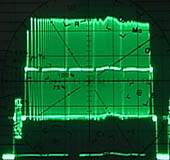 |
This is the original (unrecorded) input signal direct from the sweep
generator. Left to right, it goes from 0 to 5 MHz and as you can see is
(approximately) flat across the band. Also, the top and bottom edges of the
trace appear clean and sharp, with little amplitude noise. |
 |
This is the signal played back from a UVW 1800 Betacam SP deck. The
vertical pips (more visible in the frames below) are 1 MHz interval
markers. The last marker is at 4 MHz and the right side of the waveform is
5 MHz. It appears that the response is flat out to about 3.5 MHz and rolls
off after that.
|
 |
Here is the signal from the TRV900 DV camera (recorded & played
back through external analog in/out ports). You can see that it starts
rolling off immediately from the left (DC/0 MHz) but the slope is gradual.
It becomes steeper at about 2 MHz. Up to around 4 MHz the BetaSP has more
signal; at some point above 4 MHz the MiniDV signal is larger.
|
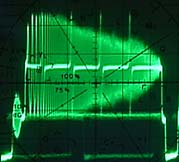 |
Here is the output from a SVHS deck. The model is JVC BRS 525. The
signal decreases more at high frequencies than the two devices above, although
surprisingly (to me) it still extends to 5 MHz. |
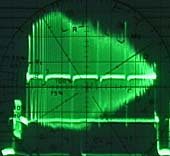 |
This is the same SVHS deck, but with the "detail enhance" feature turned
on. You can see the peak in response at about 1.5 MHz, and the steep decline
above 4 MHz.
|
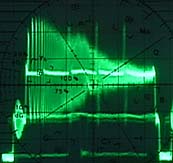 |
Here is the output from a Sony TR-101 Hi8 camcorder. It looks considerably
weaker than the SVHS deck. |
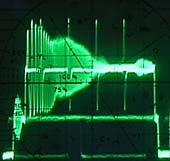 |
Finally, here is the signal from a VHS deck. You notice the complete
absence of signal above 3 MHz. The bump at 4.5 MHz is I assume noise. |
From: "Eugen" (Eugen at prodigy.net)
Date: Tue, 30 Mar 1999 08:01:34 -0800
[...] The reason for this note is that your video response measurements
use 100% multiburst. It should be 50% at most. with 100% the systems are
saturated above 2Mhz. -Gene
Back to TRV900 page.
